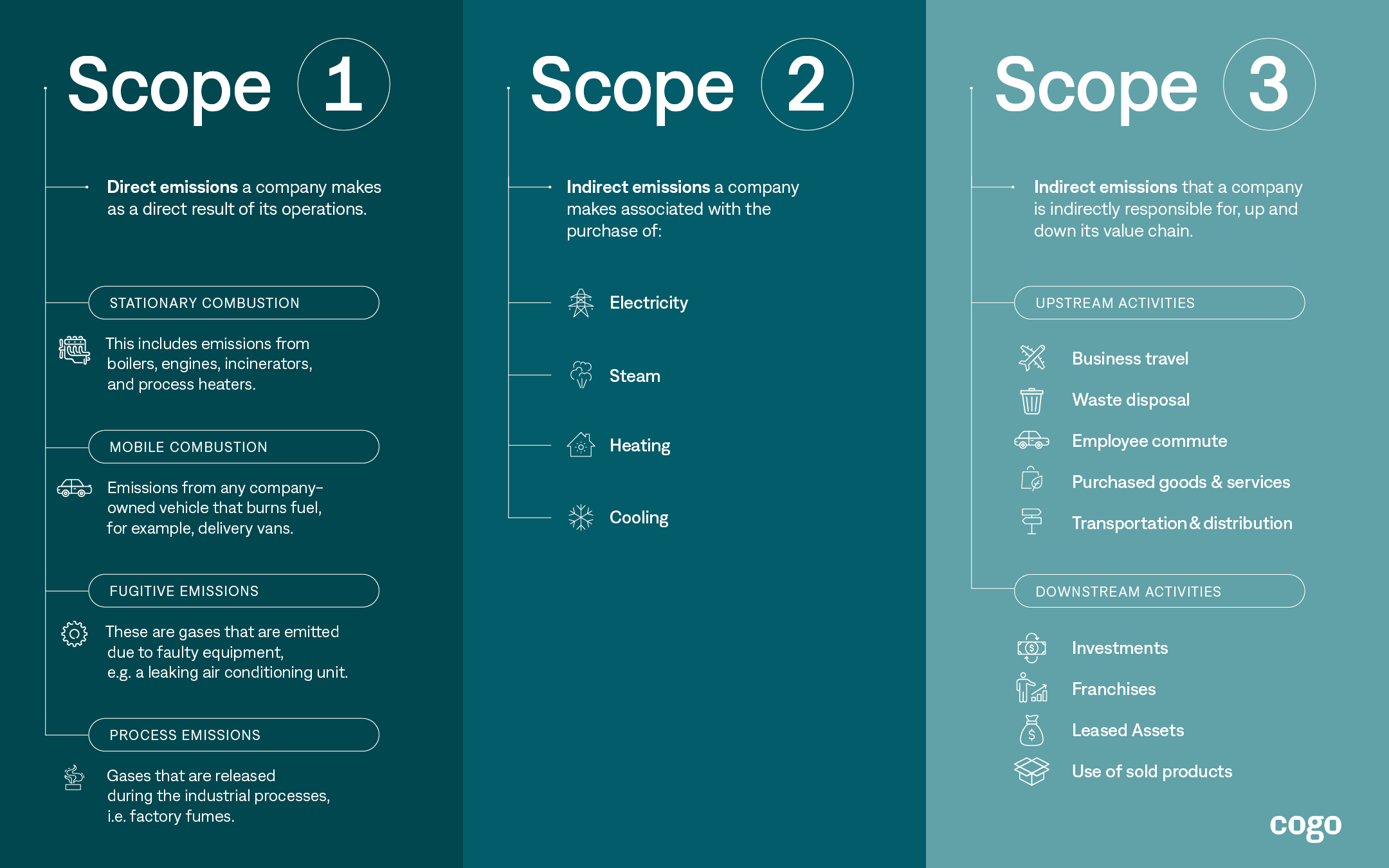20.4.2022
2
mins
By
Lucy O'Connor
What are scope emissions?
Scope emissions are a way of categorising the greenhouse gases a company is responsible for, across its operations and supply chain.
There are 3 categories:
Scope 1: Direct emissions
These are greenhouse gases a company makes as a direct result of its operations, such as:
- Stationary combustion: This includes emissions from boilers, engines, incinerators, and process heaters.
- Mobile combustion: Emissions from any company-owned vehicle that burns fuel, for example, delivery vans.
- Fugitive emissions: These are gases that are emitted due to faulty equipment, e.g. a leaking air conditioning unit.
- Process emissions: Gases that are released during the industrial processes, i.e. factory fumes.
Scope 2: Indirect emissions
This includes the emissions a company makes indirectly, generated from purchased electricity, steam, heating and cooling.
Scope 3: Value chain emissions
This is where it gets tricky. This category includes all the emissions that an organisation is indirectly responsible for, up and down its value chain. These can be grouped into:
Upstream activities:
- Business travel: This includes travel that is not owned by an organisation, for example, air travel, taxis, etc.
- Waste disposal: This relates to waste sent to landfill and wastewater treatment.
- Employee commute: Emissions generated from teams travelling to and from work.
- Purchased goods and services: The emissions related to purchases made from suppliers.
- Transportation and distribution: This occurs in upstream (suppliers) and downstream (customers) activities, and includes emissions from transport by land, sea and air, and emissions relating to third-party warehousing.
Downstream activities:
- Investments: This includes emissions from equity investments, debt investments, project finance, managed investments and client services.
- Franchises: Any emissions from franchisees operations.
- Leased assets: This corresponds to leased assets by the organisation (upstream) and assets to other organisations (downstream).
- Use of sold products: Emissions resulting from people using the product.
On average, Scope 3 accounts for more than 75% of a company’s total emissions. For banks, financed emissions can be over 90–95% of their footprint.

Why Scope 3 matters more than ever
When this blog was first written in 2022, scope 3 reporting was just gaining traction. Fast forward to 2025, and it’s now front and centre:
- Regulation is catching up. The EU’s Corporate Sustainability Reporting Directive (CSRD) makes scope 3 reporting mandatory for thousands of companies. And the UK’s Sustainability Disclosure Standards (SDS) are following suit in 2025.
- Global standards have converged. The ISSB standards now provide a baseline for comparable, decision-useful disclosures.
- Investors and customers are demanding transparency. Failing to report and reduce scope 3 is increasingly seen as a risk to financial resilience and reputation.
In short: ignoring Scope 3 is no longer an option.
Benefits of measuring all 3 scopes
Measuring Scope 1, 2 and 3 gives businesses a complete picture of their climate impact. This can help you:
- Discover emissions hotspots in your supply chain.
- Identify risks related to resources, energy and regulation.
- Engage suppliers on sustainability performance.
- Find cost-saving opportunities through efficiency.
- Build trust with customers, employees, and investors.
- Access sustainable finance by meeting disclosure expectations.
Yet despite these benefits, awareness remains low. For example, NatWest research found that 87% of UK SMEs are unaware of their total carbon emissions, even though many want to act. Why? Because assessing, calculating, managing, and reporting carbon emissions is no easy task.
"We already measure our carbon emissions; but the challenging aspect of this is measuring our Scope 3 emissions. Getting carbon emissions information from suppliers is never straightforward. Our Scope 3 emissions include inward freight, fabric supply and dying mills and we don’t have the direct relationships needed to assess these emissions accurately. At the same time, putting our head in the sand wasn’t an option and Cogo offered us a pathway to start this measurement journey immediately." Kylie Matthews of Awwa Period Care
How Cogo can help
At Cogo, we know that businesses and banks need a robust, scalable way to measure Scope 3. That’s why we built the Carbon Manager.
Unlike tools that rely on generic conversion factors, our approach is grounded in:
- Environmentally Extended Input-Output (EEIO) models of industries.
- Government statistics and academic research, developed with carbon expert Mike Berners-Lee.
- Limited assurance for credibility and transparency.
We help:
- Banks measure and reduce financed emissions, engage SMEs, and improve PCAF scores.
- Businesses of all sizes start their carbon journey with reliable, actionable insights.
Ready to get started?
Whether you’re a bank looking to strengthen your Scope 3 reporting, or a business wanting to measure and manage your footprint, Cogo can help.
Book a demo to see how the Carbon Manager works


.png)


